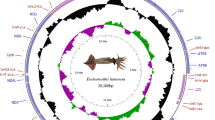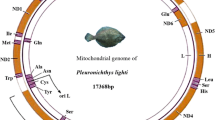Abstract
Processed copies of genes generally evolve in neutral mode as pseudogenes, however, some of them might be important sources of new functional genes. The ψPGK1 pseudogene has been discovered in Schrenck salamander (Salamandrella schrenckii, Amphibia, Caudata, Hynobiidae) via polymerase chain reaction used to amplify the phosphoglycerate kinase 1 gene (PGK1). This pseudogene is an intronless copy of PGK1 gene absent of exon 6. Analysis of ψPGK1 pseudogene polymorphism has demonstrated that it lacks mutations, which results in shifts in the stop codons and reading frames, as well as that the interspecies variation of this pseudogene was inconsistent with the neutral model of evolution. In addition, the pattern of phylogeographic differentiation of the ψPGK1 variants mainly coincides with that observed in mitochondrial DNA. These observations allow it to be suggested that the ψPGK1 pseudogene is a new functional gene in the Schrenck salamander.
Similar content being viewed by others
References
Wu, S., Storey, J.M., and Storey, K.B., Phosphoglycerate kinase 1 expression responds to freezing, anoxia, and dehydration stresses in the freeze tolerant wood frog, Rana sylvatica, J. Exp. Zool., 2009, vol. 311A, pp. 57–67.
Firth, J.D., Ebert, B.L., Pugh, C.W., and Ratcliffe, P.J., Oxygen-regulated control elements in the phosphoglycerate kinase 1 and lactate dehydrogenase A genes: similarities with the erythropoietin 30 enhancer, Proc. Natl. Acad. Sci. U.S.A., 1994, vol. 91, pp. 6496–6500.
Liu, Y.-J., Zheng, D., Balasubramanian, S., et al., Comprehensive analysis of the pseudogenes of glycolytic enzymes in vertebrates: The anomalously high number of GAPDH pseudogenes highlights a recent burst of retrotrans-positional activity, BMC Genomics, 2009, vol. 10, p. 480.
Balakirev, E.S. and Aiyala, F.J., Psevdogenes: Conservation of structure, expression and function, Zh. Obshch. Biol., 2004, vol. 65, no. 4, pp. 306–321.
Tam, O.H., Aravin, A.A., Stein, P., et al., Pseudogene-derived small interfering RNAs regulate gene expression in mouse oocytes, Nature, 2008, vol. 453, pp. 534–538.
Malyarchuk, B.A., Berman, D.I., and Derenko, M.V., Centers of genetic diversity and origin of newts of the genus Salamandrella (Salamandrella keyserlingii and Salamandrella schrenckii, Amphibia, Caudata, Hynobiidae), Dokl. Akad. Nauk, 2010, vol. 435, no. 1–6, pp. 448–452.
Berman, D.I., Derenko, M.V., Malyarchuk, B.A., et al., Intraspecific genetic differentiation in Siberian newt (Salamandrella keyserlingii, Amphibia, Caudata) and the cryptic species S. schrenskii from southeastern Russia, Zool. Zh., 2005, vol. 84, no. 11, pp. 1374–1388.
Rozen, S. and Skaletsky, H.J., Primer3 on the www for general users and for biologist programmers, Bioinformatics Methods and Protocols: Methods in Molecular Biology, Krawetz, S. and Misener, S., Eds., Totowa, NJ: Humana, 2000, pp. 365–386.
Tamura, K., Peterson, D., Peterson, N., et al., Mega5: Molecular evolutionary genetics analysis using maximum likelihood, evolutionary distance, and maximum parsimony methods, Mol. Biol. Evol., 2011, vol. 28, pp. 2731–2739.
Librado, P. and Rozas, J., DnaSP v5: A software for comprehensive analysis of DNA polymorphism data, Bioinformatics, 2009, vol. 25, pp. 1451–1452.
Nielsen, R. and Yang, Z., Likelihood models for detecting positively selected amino acid sites and applications to the HIV-1 envelope gene, Genetics, 1998, vol. 148, pp. 929–936.
McDonald, J.H. and Kreitman, M., Adaptive protein evolution at the Adh locus in Drosophila, Nature, 1991, vol. 351, pp. 652–654.
Jukes, T.H. and Cantor, C.R., Evolution of protein molecules, Mammalian Protein Metabolism, Munro, H.N., Ed., New York: Academic, 1969, pp. 121–132.
Michelson, A.M., Blake, C.C.F., Evans, S.T., and Orkin, S.H., Structure of the human phosphoglycerate kinase gene and the intron-mediated evolution and dispersal of the nucleotide-binding domain, Proc. Natl. Acad. Sci. U.S.A., 1985, vol. 82, pp. 6965–6969.
Malyarchuk, B.A., Derenko, M.V., Berman, D.I., et al., Genetic structure of Schrenck newt Salamandrella schrenckii populations by mitochondrial cytochrome b variation, Mol. Biol. (Moscow), 2009, vol. 43, no. 1, pp. 47–54.
Svensson, O., Arvestad, L., and Lagergren, J., Genome-wide survey for biologically functional pseudogenes, PLoS Comput. Biol., 2006, vol. 2, p. e46
Jeffares, D.C., Penkett, C.J., and Bahler, J., Rapidly regulated genes are intron poor, Trends Genet., 2008, vol. 24, pp. 375–378.
Long, M. and Langley, C.H., Natural selection and the origin of jingwei, a chimeric processed functional gene in Drosophila, Science, 1993, vol. 260, pp. 91–95.
Hirotsune, S., Yoshida, N., Chen, A., et al., An expressed pseudogene regulates the messenger-RNA stability of its homologous coding gene, Nature, 2003, vol. 423, pp. 91–96.
Betrán, E., Wang, W., Jin, L., and Long, M., Evolution of the phosphoglycerate mutase processed gene in human and chimpanzee revealing the origin of a new primate gene, Mol. Biol. Evol., 2002, vol. 19, pp. 654–663.
Kimura, M., The Neutral Theory of Molecular Evolution, Cambridge: Cambridge Univ. Press, 1983.
McCarrey, J.R., Nucleotide sequence of the promoter region of a tissue-specific human retroposon: Comparison with its housekeeping progenitor, Gene, 1987, vol. 61, pp. 291–298.
Maestre, J., Tchenio, T., Dhellin, O., and Heidmann, T., mRNA retroposition in human cells: Processed pseudogene formation, EMBO J., 1995, vol. 14, pp. 6333–6338.
Dierick, H.A., Mercer, J.F.B., and Glover, T.W., A phosphoglycerate mutase brain isoform (PGAM1) pseudogene is localized within the human Menkes disease gene (ATP7A), Gene, 1997, vol. 198, pp. 37–41.
Author information
Authors and Affiliations
Corresponding author
Additional information
Original Russian Text © B.A. Malyarchuk, G.A. Denisova, M.V. Derenko, 2013, published in Genetika, 2013, Vol. 49, No. 7, pp. 830–837.
Rights and permissions
About this article
Cite this article
Malyarchuk, B.A., Denisova, G.A. & Derenko, M.V. Peculiarities of phosphoglycerate kinase-1 pseudogene evolution in Schrenck salamander (Salamandrella schrenckii Strauch 1870). Russ J Genet 49, 722–729 (2013). https://doi.org/10.1134/S1022795413070107
Received:
Accepted:
Published:
Issue Date:
DOI: https://doi.org/10.1134/S1022795413070107




